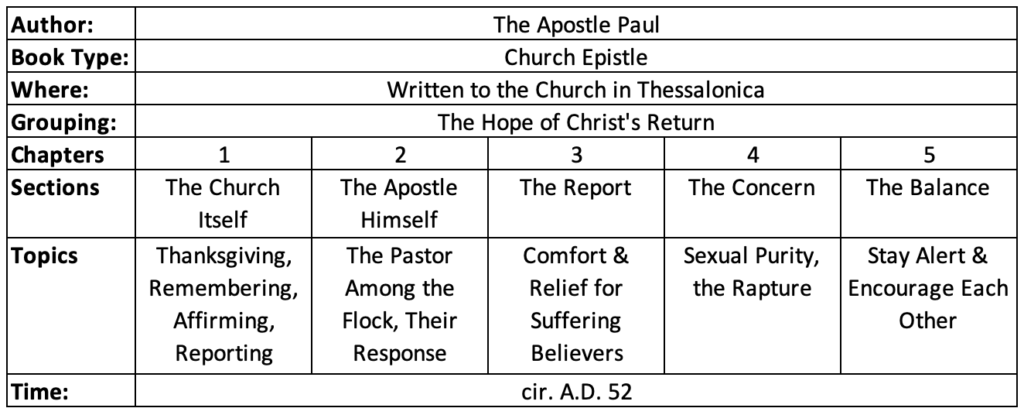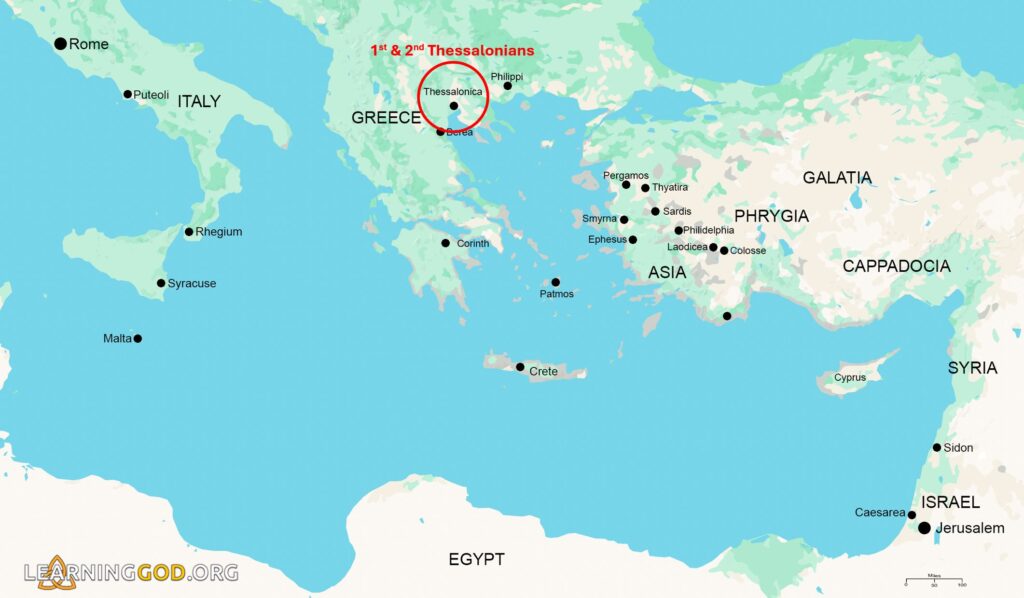1st Thessalonians
Doctrine of Eschatology
Summary | About | Why You Should Read it | Author | When Written | Context | Timeline | Location | Outline | Observations | Resources
Summary
Paul had left Thessalonica abruptly (see Ac 17:5-10) after a rather brief stay. Recent converts from paganism (1:9) were thus left with little external support in the midst of persecution. Paul’s purpose in writing this letter was to encourage the new converts in their trials (3:3-5), to give instruction concerning godly living (4:1-12) and to give assurance concerning the future of believers who die before Christ returns (4:13-18; see Theme below; see also notes on 4:13,15).
Although the thrust of the letter is varied (see Purpose), the subject of eschatology (doctrine of last things) seems to be predominant in both Thessalonian letters. Every chapter of 1 Thessalonians ends with a reference to the second coming of Christ, with ch. 4 giving it major consideration (1:9-10; 2:19-20; 3:13; 4:13- 18; 5:23-24). Thus, the second coming seems to permeate the letter and may be viewed in some sense as its theme. The two letters are often designated as the eschatological letters of Paul.
The table below is a high-level look at the structure and contents of 1st Thessalonians.

About
The first epistle to the Thessalonians is the 13th book of the New Testament and Paul’s 8th book (by biblical order, not chronological order).

Why You Should Read It
With the primary focus of the letter being on the second coming of Christ, this is most relevant today, as we approach that time. Paul’s explanation of the second coming in this and the subsequent letter help us to understand what to look for regarding the Lord’s return.
Author
Paul is declared to be the author of this epistle (see 1:1 and 2:18). There is little argument as to his authorship. Marcion and other early church writers agreed on this matter, with testimonies as early as 140 A.D. attesting to his authorship. Paul’s known characteristics are clear in the letter (3:1-2, 3:8-11 compared with Act 15:36; 2Co 11:28). Historical allusions in the book fit Paul’s life as recounted in Acts and in his own letters (2:14-16 compared with Act 17:5-10; 3:6 compared with Act 17:16).
When Written
Paul’s first epistle to the Thessalonians was written in the early 50’s A.D., probably around 52 A.D.
Context
Thessalonica was a bustling seaport city at the head of the Thermaic Gulf. It was an important communication and trade center, located at the junction of the great Egnatian Way and the road leading north to the Danube. It was the largest city in Macedonia and was also the capital of its province.
The background of the Thessalonian church is found in Act 17:1-9. Since Paul began his ministry there in the Jewish synagogue, it is reasonable to assume that the new church included some Jews. However, 1:9-10; Act 17:4 seem to indicate that the church was largely Gentile in membership.
Paul visited Thessalonica on his 2nd missionary journey in 51 A.D. and spent about 3 weeks with them. This letter was written about a year later in 52 A.D. to address slanderous and false accusations that were being circulated in the mostly gentile church.
The Jews had recently been expelled from Rome and were causing problems for the Christians in the area.
Timeline
The general order of events from the New Testament period of the early 50s to the early 60s is shown below.
Location
The city of Thessalonica is on coast of Macedonia, in modern day Greece.
Outline
The Thanksgiving for the Thessalonians (ch. 1)
The Grounds for the Thanksgiving (1:1-4)
The Genuineness of the Grounds (1:5-10)
The Defense of the Apostolic Actions and Absence (chs. 2-3)
The Defense of the Apostolic Actions (2:1-16)
The Defense of the Apostolic Absence (2:17; 3:10)
The Prayer (3:11-13)
The Exhortations to the Thessalonians (4:1;5:22)
Primarily concerning Personal Life (4:1-12)
Concerning the Coming of Christ (4:13; 5:11)
Primarily concerning Church Life (5:12-22)
The Concluding Prayer, Greetings and Benediction (5:23-28)
Observations
- Not only is 1 Thessalonians the first of two letters to the church at Thessalonica, it is Paul’s first letter period.
- 2 Thessalonians would be his 2nd letter.
- Thus, Paul’s first two letters were written to Thessalonica.
- Paul established the congregation at Thessalonica during his 2nd missionary journey, and remained there for about one month.
- After Paul’s forced separation from the Thessalonians, he grows increasingly concerned about the progress of their young faith.
- Upon hearing of their progress from Timothy, he writes 1 Thessalonians.
- In 1 Thessalonians, Paul:
- Commends the Thessalonian brethren for remaining steadfast under some difficult afflictions.
- Exhorts them to excel in their Christian walk.
- Consoles them concerning Christian loved one who have died.
- Paul encourages the Thessalonica brethren:
- To increase brotherly love
- To pray
- To rejoice
- To give thanks always
- In Paul’s salutation to the brethren at Thessalonica:
- He uses the customary Greek, “grace.”
- He uses the customary Hebrew, “peace.”
- In writing to the church at Thessalonica, Paul deals with the subject of the 2nd coming of Christ.
- It is mentioned in 23 of the 27 New Testament books.
- Of 7,959 verses in the New Testament, at least 370 of them refer to the 2nd coming of Christ.
- 1 Out of every 21 verses in the New Testament touches on the subject of the Lord’s return.
- The city of Thessalonica.
- Capital of the Roman province of Macedonia.
- A prominent seaport city.
- Situated on the great northern military highway from Rome to the east.
- Located 100 miles west of Philippi.
“Test all things; hold fast what is good.”
1 Thessalonians 5:21
Sections in I Thessalonians
- Looking back 1-3
- Church itself 1
- Paul himself 2
- The suffering Christians 3
- Looking ahead 4-5
- Prophetic urgency 4
- Stay alert! 5
Theme
- The hope of Christ’s return comforts us and motivates us to godly living.
- This epistle focuses on the eschatological prophecies of Christ’s second coming and rapture.
Jesus in I Thessalonians
- Jesus is our source of hope and comfort, the One who rescues believers from the coming wrath (1:10; 4:13-5:11).


